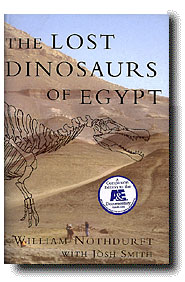The Lost Dinosaurs of Egypt
by William Nothdurft and Josh Smith (Contributor)
Random House, New York, 2002, 256
p.
ISBN: 0375507957. $24.95 (cloth)

The Lost Dinosaurs of Egypt
|
 |
In 1993, Louis Jacobs wrote in his book Quest for the African Dinosaurs, “Dinosaurs are scary giants: Africa is the Dark Continent. Those perceptions of dinosaurs and of Africa are partly myth, partly true; nevertheless the appeal they engender seems to be enduring for each.” Certainly this same sense of appreciation for both dinosaurs and Africa was behind John Parkinson’s popular 1930 book, The Dinosaur in East Africa. The Lost Dinosaurs of Egypt keeps with this tradition of telling a dinosaurian-based adventure story in Africa, though in fact this new book tells two stories. One is old and generally forgotten by most fans of dinosaurs, and the second is arguably premature in its telling.
The first of these stories is that of Ernst Freiherr Stromer von Reichenbach, a German paleontologist who explored the Bahariya Depression in Egypt in the early part of the 20th century. Stromer’s story is full of trials and tribulations that he faced in his ultimate discovery of several new, albeit fragmentary, dinosaur skeletons. His story is set against a backdrop of limited funding, limited institutional support, and a political situation that includes the outbreak of World War I. Stromer eventually published several impressive papers describing in some detail these interesting discoveries. Ultimately, World War II came to play a role in his professional life when the British inadvertently bombed the building in Munich housing Stromer’s collections, destroying all of his specimens, thus leaving only his impressive publication record as evidence of his life’s work.
At one point in Stromer’s story, the book seems incredulous that the world did not stop to appreciate the fragmentary dinosaur remains discovered by Stromer in the mid-teens. The book does concede that the outbreak of World War I may have had a role in that neglect. I would also speculate that perhaps what little enthusiasm the western world had left for scientific discovery was spent on the truly spectacular explorations going on in the polar regions, particularly the southern region. Exploration of Antarctica was in full swing with the life-and-death adventures of Shackleton, Scott, and Amundsen. Meanwhile, in the north, the great Peary-Cook controversy over the attainment of the North Pole was also raging in the public’s eye. Perhaps these exploits, to the disappointment of the participants in this book, outshone the discovery of fragmentary dinosaurs. Overall, despite the forgotten nature of Stromer’s accomplishments to all but the dinosaur specialist, Stromer’s story appeals to anyone that has ever had to conceive, plan, and execute a difficult expedition of exploration and thus the story is timeless.
In contrast to this first story which is a summation of an individual’s life’s work, the second story in The Lost Dinosaurs of Egypt is of a group of, then, graduate students from the University of Pennsylvania and associated faculty from that school and Drexel University, and their attempt to relocate Stromer’s localities. They eventually stumble upon his old localities and make some contributions of their own. Their story is simple, and silly in places. Given the lack of a publication legacy comparable to that of Stromer, comments here on the scientific claims made in this book for a popular audience are inappropriate. Debate is best served after thorough publication in the scientific arena by the participants of this latter-day expedition.
That said, I was struck by a couple of non-scientific points within the second story. The authors seem to devote a great deal of attention to the use of a Global Positioning System (GPS) on the Bahariya project, to the point where they seem enamored by the technology and very self-satisfied. Paleontological projects have used GPS units since at least the early 1990s, and application of GPS units to biological and geological projects predates even that. Yet the authors present the use of GPS units at Bahariya as novel and innovative.
Another observation regarding this latter story is with respect to the dialog between the student participants. Included in the banter of the field party were vocabulary such as “dude” and “dumbass” which I found detracted from the story, thus portraying the participants as adolescents run amok on the outcrop. I recently read a review of this book by Laura M. Miller for Curled Up with a Good Book, where she made the same observation, making her refer to this latter day tale as Bill and Ted’s Excellent Egyptian Adventure. After struggling with how to encapsulate this part of the book, I can do no better than Laura Miller’s description.
In summary, I found part of the book enlightening because it was a story related to the history of dinosaur paleontology and provided me a broader perspective on the accomplishments of those that came before me. I enjoyed that component of the book enough that it overrode the silliness of the second component of The Lost Dinosaurs of Egypt.